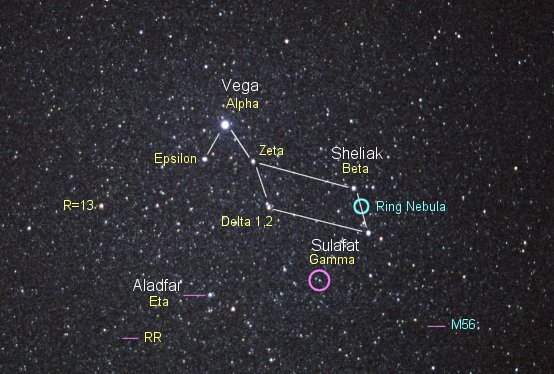 A massive planet orbits a fainter companion to HR 7272 A (HR 7272
B) in Lyra, which is itself a close double, making the planet part
of a triple star system.
A massive planet orbits a fainter companion to HR 7272 A (HR 7272
B) in Lyra, which is itself a close double, making the planet part
of a triple star system.
THE PLANET
The purple circle shows the location of the class G dwarf star HR 7272 B,
found in the constellation Lyra. HR 7272
A, the brighter of a wide double, is the brighter of the two close
to the center of the circle. The other is not the companion and is
of no consequence here. HR 7272 B is only 16 seconds of arc from
HR 7272 A and over a magnitude fainter, and is not visible in the
picture (but can be seen easily through a small telescope). With
a hefty mass of at least 6.92 times that of Jupiter, HR 7272 B's
planet orbits with a period of 71.49 days at an average distance of
0.32 Astronomical Units (48 million kilometers, 30 million miles),
83 percent of Mercury's distance from the Sun. A modest
eccentricity takes the planet between 0.36 and 0.28 AU from its
star.
|
 A massive planet orbits a fainter companion to HR 7272 A (HR 7272
B) in Lyra, which is itself a close double, making the planet part
of a triple star system.
A massive planet orbits a fainter companion to HR 7272 A (HR 7272
B) in Lyra, which is itself a close double, making the planet part
of a triple star system.
 A massive planet orbits a fainter companion to HR 7272 A (HR 7272
B) in Lyra, which is itself a close double, making the planet part
of a triple star system.
A massive planet orbits a fainter companion to HR 7272 A (HR 7272
B) in Lyra, which is itself a close double, making the planet part
of a triple star system.